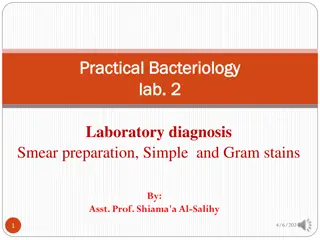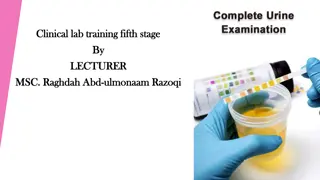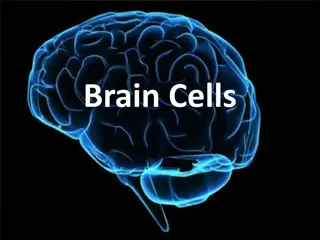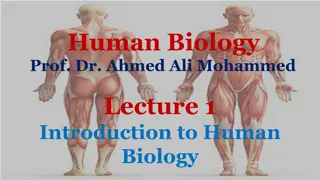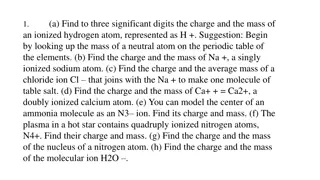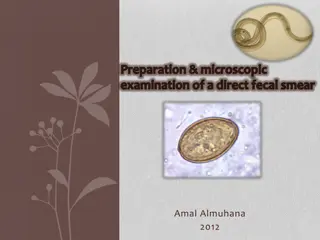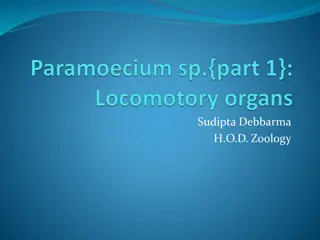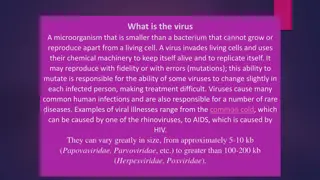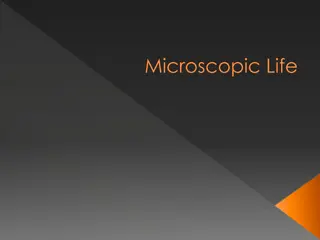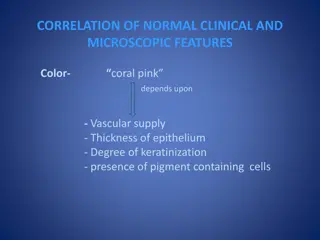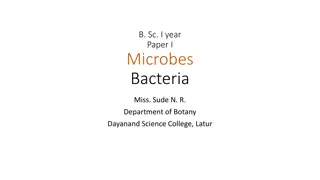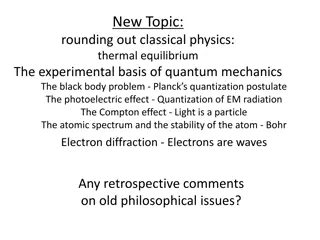Equipment Management - LABS FOR LIFE PROJECT - INDIA
Histopathology and cytology equipment, focusing on the tissue processor, important parts, maintenance, and steps in tissue processing. Understand the significance of these tools in the microscopic examination of tissues for disease manifestations.
5 views • 30 slides
Practical Bacteriology Laboratory Diagnosis and Sample Collection
This practical guide focuses on laboratory diagnosis steps in bacteriology, covering specimen collection, microscopic examination, culture tests, biochemical tests, serological tests, and molecular tests. Learn about various sample collection methods for urine, stool, swabs, sputum, pus, CSF, and mo
3 views • 23 slides
Exploring Surface Tension and Wettability in Nature
Discover the fascinating world of surface tension and wettability through engaging experiments and observations, from water cohesion on a penny to the microscopic structures on lotus leaves. Delve into the role of cohesion and adhesion, surface wettability factors, and everyday applications of these
2 views • 17 slides
Heisenberg's Uncertainty Principle in Elementary Quantum Mechanics
Heisenberg's Uncertainty Principle, proposed by German scientist Werner Heisenberg in 1927, states the impossibility of simultaneously and accurately determining the position and momentum of microscopic particles like electrons. This principle challenges classical concepts of definite position and m
0 views • 49 slides
Understanding Urinalysis: Importance and Interpretation
Urinalysis is a crucial diagnostic test used to detect various disorders like infections, kidney diseases, and diabetes by examining the physical, chemical, and microscopic properties of urine. It involves assessing color, specific gravity, and chemical content, such as pH and protein levels. The in
0 views • 22 slides
Brain Cells
Delve into the fascinating world of brain cells and neurons to understand their structure, function, and communication process. Explore the microscopic level composition of the brain, the significance of neuron shapes, and the intricate workings of synapses in transmitting signals between neurons. U
1 views • 14 slides
3D Cell Culture Market to be Worth $4.02 Billion by 2030
3D cell culture is frequently employed in research that requires in vivo model systems to test the impact of a foreign substance on physiological organs or tissues since they can closely mimic the structure and microscopic structure of organs.
0 views • 9 slides
Yeast Breads Preparation Guide
Explore the world of yeast breads with essential information on yeast, ingredients, terms to know, mixing methods, and baking tips for successful bread making. Learn about the role of yeast as a microscopic plant and the key ingredients needed to create delicious bread. Discover important techniques
0 views • 12 slides
Histological Structure of Liver and Spleen: Key Features and Functions
In this informative content, the histological structures of the liver and spleen are explored in detail. Key components such as hepatocytes, sinusoids, bile canaliculi, and the spaces of Disse in the liver, and the white pulp and red pulp in the spleen are highlighted. The classic liver lobule, cent
2 views • 10 slides
Introduction to Human Biology: Overview of Branches and Studies
Human Biology encompasses various fields such as Anatomy, Physiology, Genetics, and more. It involves the study of life from microscopic tissues to complex organisms, emphasizing the structure, function, and interactions within biological systems.
0 views • 22 slides
Basic Concepts of Microscopy for Materials Study
Microscopy plays a crucial role in examining the structural elements and defects influencing material properties. This involves studying microscopic features like grain size and shape using optical, electron, and scanning probe microscopes. Microstructural examinations help understand property-struc
1 views • 12 slides
Features of an Appropriate Capital Structure and Optimum Capital Structure
While developing a suitable capital structure, the financial manager aims to maximize the long-term market price of equity shares. An appropriate capital structure should focus on maximizing returns to shareholders, minimizing financial insolvency risk, maintaining flexibility, ensuring the company
3 views • 5 slides
Understanding the Histological Structure of Muscle Cells
This presentation delves into the histological structure of three types of muscle cells - skeletal, cardiac, and smooth muscles. Learn about their differences, such as striation, voluntary vs. involuntary control, and cellular organization. Discover the components of muscular tissue, the coverings o
0 views • 13 slides
Atomic Charges and Masses Calculations
Calculate the charges and masses of various ions and atoms, including hydrogen, sodium, chloride, calcium, nitrogen, and more. Explore scenarios involving electron count, electrical forces, gravitational forces, and their effects. The content encompasses physics concepts related to atomic structure,
0 views • 15 slides
Direct Fecal Smear Preparation and Microscopic Examination Procedure
Direct fecal smears are useful for quick screenings to detect intestinal parasites. This article outlines the preparation and microscopic examination procedure for direct fecal smears. It covers advantages, disadvantages, fecal collection methods, and steps for preparing and examining fecal smears u
0 views • 16 slides
Thyroid and Parathyroid Glands Histological Structure Overview
This detailed histological study covers the structure and function of the thyroid and parathyroid glands. It includes information on the stroma, parenchyma, follicular cells, parafollicular cells, and the microscopic structure of the parathyroid gland. The article also delves into the functions of v
0 views • 8 slides
Understanding Histological Techniques for Tissue Preparation
Histological technique involves preparing tissue for microscopic examination, aiming to preserve the microscopic anatomy and structure of tissues. The process includes fixation, dehydration, cleaning, embedding, cutting, and staining. Key steps like fixation using fixative materials help prevent aut
0 views • 18 slides
Understanding Paramoecium Caudatum: A Microscopic Organism with Unique Characteristics
Paramoecium caudatum is a typical ciliate protozoan characterized by the presence of cilia as a locomotor organelle, nuclear dimorphism, and a unique form of sexual reproduction called conjugation. Commonly found in freshwater habitats, this microscopic organism has a distinct structure with a pelli
3 views • 10 slides
Microscopic Structure and Histology of Kidney and Urinary Tract
Explore the intricate details of kidney anatomy, nephron structure, glomerular filtration barrier, and the histology of renal cortex and medulla, renal corpuscle, proximal and distal tubules, juxtaglomerular apparatus, as well as the urinary bladder and urethra in both male and female. Delve into th
0 views • 17 slides
Fungal Microbiology Laboratory Procedures
This content provides detailed guidelines on fungal culture purification, subculturing process, preparation of microscopic slides for fungal micromorphology assessment, and isolation of human samples for diagnosing fungal infections. The procedures include steps for identifying characteristics of in
1 views • 9 slides
Understanding the Microscopic Structure and Function of the Pituitary Gland
Explore the detailed histology of the pituitary gland, focusing on its adenohypophysis and neurohypophysis components. Learn about the diverse parenchymal cells, including acidophils, basophils, and chromophobes, and their respective functions in hormone production. Dive into the significance of the
0 views • 6 slides
Introduction to Histology and Microscopy in Anatomy
Histology is the study of tissue structure and function in animals and plants, focusing on the microscopic structure of cells, tissues, and organs. It helps in understanding the relationship between structure and function, intertwining disciplines like cell biology, pathology, physiology, and bioche
0 views • 5 slides
Introduction to Histology and Cell Structure
Histology is the microscopic study of normal tissues utilizing light and electron microscopes. This field explores the composition and function of cells, focusing on the nucleus, cytoplasm, organelles, and inclusions. Thin tissue sections stained with Haematoxylin and Eosin reveal distinct cellular
0 views • 23 slides
Understanding Viruses: Origin, Structure, and Importance in Research
Viruses are microscopic organisms that rely on living cells to replicate and cause a range of illnesses in humans, animals, and plants. Studying viruses has led to significant scientific breakthroughs, providing insights into essential biological mechanisms and disease processes. Theories on the ori
0 views • 20 slides
Introduction to Botany: The Study of Plant Life
Biology, the science of living organisms, includes botany which focuses on studying plants' structure, living habits, and relationships. The plant kingdom is diverse, with some being microscopic while others are large trees. Cryptogams are flowerless plants that reproduce both sexually and asexually
0 views • 13 slides
Histology of the Eye: Structure and Function Overview
Explore the histology of the eye, covering the general structure and the microscopic details of the cornea and retina. Learn about the three coats of the eye bulb, including the fibrous, vascular, and neural tunics. Dive into the composition of the cornea, from its transparent and highly innervated
0 views • 24 slides
Understanding Atoms: From Structure to Models
Explore the fundamental building blocks of matter - atoms. Discover what materials are made of, delve into atomic theories, examine Bohr models, and learn about the intricate components such as protons, neutrons, and electrons. Engage in a journey through the microscopic world of atoms and their sig
0 views • 34 slides
Atomic Discoveries: Unveiling the Secrets of the Microcosm
Explore the realm of atomic structure and key discoveries through experiments such as the cathode ray tube, Milliken's oil drop experiment, and Rutherford's gold foil experiment. Delve into the world of electrons, isotopes, and quantum theory as you uncover the fundamental building blocks of matter
0 views • 55 slides
Exploring Microscopic Life Through a Microscope
Journey into the microscopic world by examining Elodea leaves and Paramecium under a microscope. Discover the intricate details of these tiny organisms, observe their movement, and learn about their structures. Engage in hands-on activities to explore the fascinating realm of microscopic life.
0 views • 16 slides
Microscopic Structure of Blood Vessels and Their Layers
The lecture covers the microscopic structure of the wall of blood vessels including large veins, elastic arteries, muscular arteries, and blood capillaries. The three concentric layers of blood vessel walls are discussed, which include the tunica intima, tunica media, and tunica adventitia. Detailed
0 views • 11 slides
Understanding DNA Structure and Denaturation Process
DNA is a double helical structure made of 2 antiparallel polynucleotide chains with nucleotide monomers. The structure contains deoxyribose sugar, phosphate groups, and nitrogenous bases (purines and pyrimidines). Hydrogen bonds between base pairs stabilize the structure. Denaturation can occur due
0 views • 16 slides
Protein Secondary Structure Prediction: Insights and Methods
Accurate prediction of protein secondary structure is crucial for understanding tertiary structure, predicting protein function, and classification. This prediction involves identifying key elements like alpha helices, beta sheets, turns, and loops. Various methods such as manual assignment by cryst
0 views • 30 slides
Understanding the Hierarchy of Protein Structure
To understand proteins' final shape and function, one must grasp the primary, secondary, tertiary, and quaternary structure levels. Proteins, composed of amino acids, fold into various shapes crucial for their roles such as signaling, catalysis, and structure. The primary structure represents the am
0 views • 28 slides
Fascinating Microscopic World: Leech Feeding and Grasshopper Exoskeleton
Explore the intricate details of a leech feeding on beef kidney and a Grasshopper's cleaned-out exoskeleton by The E. obscura in these captivating microscopic images.
0 views • 7 slides
Understanding Connective Tissue Wrappings and Skeletal Muscle Structure
Exploring the connective tissue wrappings and attachments of skeletal muscles, this content highlights the cord-like structures, collagen fibers, and their role in connecting muscle bellies to bones. It also delves into the surrounding connective tissues such as fascia, epimysium, perimysium, and en
0 views • 11 slides
Exploring the Fundamentals of Plant Pathology: Understanding Viruses in Plant Diseases
Delve into the world of plant pathology with Mr. Vikash Kumar, as you learn about the nature, structure, and transmission of viruses affecting plants. Explore the important characteristics of plant viruses, their unique properties, and how they interact within plant cells. Gain insights into viral d
0 views • 14 slides
Understanding Interfacial Defects and Microscopy in Materials Science
Interfacial defects are boundaries separating regions with different crystal structures, like grain boundaries in polycrystalline materials. Microscopic examination distinguishes between macroscopic and microscopic dimensions, analyzed through optical and electron microscopy methods. Electron micros
0 views • 9 slides
Understanding Correlation of Normal Clinical and Microscopic Features in Gingival Health
The correlation of normal clinical and microscopic features in gingival health involves factors such as color, size, contour, shape, consistency, surface texture, stippling, position, and continuous tooth eruption. These elements depend on various aspects like vascular supply, thickness of epitheliu
0 views • 13 slides
Detailed Overview of Bacteria's Structure and Function
Explore the world of bacteria with a focus on their microscopic nature, general characteristics, ultrastructure of bacterial cells, and components like cell envelope, cytoplasm, and nuclear material. Uncover the diverse forms of bacteria, their mode of nutrition, reproduction methods, and unique fea
0 views • 12 slides
Exploring the Interplay Between Classical Physics and Thermodynamics in Quantum Mechanics
Delve into the foundational principles of classical physics and thermodynamics that paved the way for the development of quantum mechanics. From the black body problem to the quantization postulate by Planck, discover how key phenomena like the photoelectric effect and Compton effect shaped the unde
0 views • 20 slides

